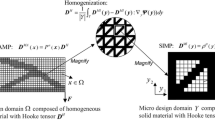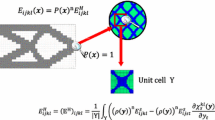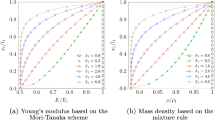Abstract
Most of the multiscale topology optimization (TO) approaches, which have been proposed for multi-material designs, are based on the assumption of deterministic loads and the exclusion of uncertain quantities like positions, directions, and magnitudes of loads. This contribution deals with: (1) multiscale design; (2) multi-materials; (3) loading uncertainties; and (4) incompressible materials such as rubbers and biological soft tissues. The proposed approach, in this paper is to exploit polytopal composite finite elements (PCEs) to overcome the inherent volumetric locking phenomenon in incompressible materials and employ adaptive geometric components (AGCs) to model porous multi-materials on an analysis grid of PCEs, which allows simultaneously optimizing incompressible multi-materials at both macro- and micro-scales. Besides the mixed displacement–pressure formulation and traditional concurrent TO, the proposed approach is purely developed from the displacement formulation and the AGCs-based direct-multiscale TO whose only constraint is global volume. The effectiveness of the current technique was demonstrated by solving several examples of incompressible porous multi-material designs under single and multiple random loads.


















Similar content being viewed by others
References
Sussman T, Bathe KJ (1987) A finite element formulation for nonlinear incompressible elastic and inelastic analysis. Comput Struct 26:357–409. https://doi.org/10.1016/0045-7949(87)90265-3
Sigmund O, Clausen PM (2007) Topology optimization using a mixed formulation: sn alternative way to solve pressure load problems. Comput Methods Appl Mech Eng 196:1874–1889. https://doi.org/10.1016/j.cma.2006.09.021
Bruggi M, Venini P (2007) Topology optimization of incompressible media using mixed finite elements. Comput Methods Appl Mech Eng 196:3151–3164. https://doi.org/10.1016/j.cma.2007.02.013
Srivasista N, Tong L (2012) Design and testing of pressurized cellular planar morphing structures. AIAA J 50:1328–1338. https://doi.org/10.2514/1.J051427
Bruggi M, Venini P (2008) Eigenvalue-based optimization of incompressible media using mixed finite elements with application to isolation devices. Comput Methods Appl Mech Eng 197:1262–1279. https://doi.org/10.1016/j.cma.2007.11.013
Zhang G, Alberdi R, Khandelwal K (2018) Topology optimization with incompressible materials under small and finite deformations using mixed u/p elements. Int J Numer Methods Eng 115:1015–1052. https://doi.org/10.1002/nme.5834
Pereira A, Talischi C, Paulino GH, Ivan IF, Carvalho MS (2016) Fluid flow topology optimization in PolyTop: stability and computational implementation. Struct Multidiscip Optim 54:1345–1364. https://doi.org/10.1007/s00158-014-1182-z
Bendsoe MP, Kikuchi N (1988) Generating optimal topologies in structural design using a homogenization method. Comput Methods Appl Mech Eng 71:197–224. https://doi.org/10.1016/0045-7825(88)90086-2
Groen JP, Sigmund O (2018) Homogenization-based topology optimization for high-resolution manufacturable microstructures. Int J Numer Methods Eng 113:1148–1163. https://doi.org/10.1002/nme.5575
Sivapuram R, Dunning PD, Kim HA (2016) Simultaneous material and structural optimization by multiscale topology optimization. Struct Multidiscip Optim 54:1267–1281. https://doi.org/10.1007/s00158-016-1519-x
Li H, Luo Z, Gao L, Qin Q (2018) Topology optimization for concurrent design of structures with multi-patch microstructures by level sets. Comput Methods Appl Mech Eng 331:536–561. https://doi.org/10.1016/j.cma.2017.11.033
Deng J, Yan J, Cheng G (2013) Multi-objective concurrent topology optimization of thermoelastic structures composed of homogeneous porous material. Struct Multidiscip Optim 47:583–597. https://doi.org/10.1007/s00158-012-0849-6
Yan J, Guo X, Cheng G (2016) Multi-scale concurrent material and structural design under mechanical and thermal loads. Comput Mech 57:437–446. https://doi.org/10.1007/s00466-015-1255-x
Xia L, Breitkopf P (2017) Recent advances on topology optimization of multiscale nonlinear structures. Arch Comput Methods Eng 24:227–249. https://doi.org/10.1007/s11831-016-9170-7
Vicente WM, Zuo ZH, Pavanello R, Calixto TKL, Picelli R, Xie YM (2016) Concurrent topology optimization for minimizing frequency responses of two-level hierarchical structures. Comput Methods Appl Mech Eng 301:116–136. https://doi.org/10.1016/j.cma.2015.12.012
Deng J, Pedersen CBW, Chen W (2019) Connected morphable components-based multiscale topology optimization. Front Mech Eng 14:129–140. https://doi.org/10.1002/nme.1620240207
Fu J, Li H, Gao L, Xiao M (2019) Design of shell-infill structures by a multiscale level set topology optimization method. Comput Struct 212:162–172. https://doi.org/10.1016/j.compstruc.2018.10.006
Wadbro E, Niu B (2019) Multiscale design for additive manufactured structures with solid coating and periodic infill pattern. Comput Methods Appl Mech Eng 357:112605. https://doi.org/10.1016/j.cma.2019.112605
Groen JP, Wu J, Sigmund O (2019) Homogenization-based stiffness optimization and projection of 2D coated structures with orthotropic infill. Comput Methods Appl Mech Eng 349:722–742. https://doi.org/10.1016/j.cma.2019.02.031
Hoang VN, Nguyen NL, Tran P, Qian M, Nguyen-Xuan H (2020) Adaptive concurrent topology optimization of cellular composites for additive manufacturing. JOM 72:2378–2390. https://doi.org/10.1007/s11837-020-04158-9
Hoang VN, Tran P, Vu V-T, Nguyen-Xuan H (2020) Design of lattice structures with direct multiscale topology optimization. Compos Struct 252:112718. https://doi.org/10.1016/j.compstruct.2020.112718
Hoang VN, Tran P, Nguyen N-L, Hackl K, Nguyen-Xuan H (2020) Adaptive concurrent topology optimization of coated structures with nonperiodic infill for additive manufacturing. Comput Des 129:102918. https://doi.org/10.1016/j.cad.2020.102918
Sigmund O, Torquato S (1997) Design of materials with extreme thermal expansion using a three-phase topology optimization method. J Mech Phys Solids 45:1037–1067. https://doi.org/10.1016/S0022-5096(96)00114-7
Gibiansky LV, Sigmund O (2000) Multiphase composites with extremal bulk modulus. J Mech Phys Solids 48:461–498. https://doi.org/10.1016/S0022-5096(99)00043-5
Luo Z, Tong L, Luo J, Wei P, Wang MY (2009) Design of piezoelectric actuators using a multiphase level set method of piecewise constants. J Comput Phys 228:2643–2659. https://doi.org/10.1016/j.jcp.2008.12.019
Huang X, Xie YM (2009) Bi-directional evolutionary topology optimization of continuum structures with one or multiple materials. Comput Mech 43:393–401. https://doi.org/10.1007/s00466-008-0312-0
Zhang W, Song J, Zhou J, Du Z, Zhu Y, Sun Z, Guo X (2018) Topology optimization with multiple materials via moving morphable component (MMC) method. Int J Numer Methods Eng 113:1653–1675. https://doi.org/10.1002/nme.5714
Kazemi H, Vaziri A, Norato JA (2018) Topology optimization of structures made of discrete geometric components with different materials. J Mech Des 140:111401. https://doi.org/10.1115/1.4040624
Wang X, Long K, Hoang VN, Hu P (2018) An explicit optimization model for integrated layout design of planar multi-component systems using moving morphable bars. Comput Methods Appl Mech Eng 342:46–70. https://doi.org/10.1016/j.cma.2018.07.032
Hoang VN, Nguyen NL, Nguyen-Xuan H (2020) Topology optimization of coated structure using moving morphable sandwich bars. Struct Multidiscip Optim 61:491–506. https://doi.org/10.1007/s00158-019-02370-z
Carrasco M, Ivorra B, Ramos AM (2012) A variance-expected compliance model for structural optimization. J Optim Theory Appl 152:136–151. https://doi.org/10.1007/s10957-011-9874-7
Chen S, Chen W, Lee S (2010) Level set based robust shape and topology optimization under random field uncertainties. Struct Multidiscip Optim 41:507–524. https://doi.org/10.1007/s00158-009-0449-2
Lazarov BS, Schevenels M, Sigmund O (2012) Topology optimization considering material and geometric uncertainties using stochastic collocation methods. Struct Multidiscip Optim 46:597–612. https://doi.org/10.1007/s00158-012-0791-7
Zhao J, Wang C (2014) Robust topology optimization under loading uncertainty based on linear elastic theory and orthogonal diagonalization of symmetric matrices. Comput Methods Appl Mech Eng 273:204–218. https://doi.org/10.1016/j.cma.2014.01.018
Richardson JN, Coelho RF, Adriaenssens S (2016) A unified stochastic framework for robust topology optimization of continuum and truss-like structures. Eng Optim 48:334–350. https://doi.org/10.1080/0305215X.2015.1011152
Guo X, Zhao X, Zhang W, Yan J, Sun G (2015) Multi-scale robust design and optimization considering load uncertainties. Comput Methods Appl Mech Eng 283:994–1009. https://doi.org/10.1016/j.cma.2014.10.014
Cai J, Wang C, Fu Z (2020) Robust concurrent topology optimization of multiscale structure under single or multiple uncertain load cases. Int J Numer Methods Eng 121:1456–1483. https://doi.org/10.1002/nme.6275
Zheng J, Luo Z, Li H, Jiang C (2018) Robust topology optimization for cellular composites with hybrid uncertainties. Int J Numer Methods Eng 115:695–713. https://doi.org/10.1002/nme.5821
Zheng J, Luo Z, Jiang C, Gao J (2019) Robust topology optimization for concurrent design of dynamic structures under hybrid uncertainties. Mech Syst Signal Process 120:540–559. https://doi.org/10.1016/j.ymssp.2018.10.026
Deng J, Chen W (2017) Concurrent topology optimization of multiscale structures with multiple porous materials under random field loading uncertainty. Struct Multidiscip Optim 56:1–19. https://doi.org/10.1007/s00158-017-1689-1
Wu Y, Li E, He ZC, Lin XY, Jiang HX (2020) Robust concurrent topology optimization of structure and its composite material considering uncertainty with imprecise probability. Comput Methods Appl Mech Eng 364:1–43. https://doi.org/10.1016/j.cma.2020.112927
Jalalpour M, Tootkaboni M (2016) An efficient approach to reliability-based topology optimization for continua under material uncertainty. Struct Multidiscip Optim 53:759–772. https://doi.org/10.1007/s00158-015-1360-7
Richardson JN, Filomeno Coelho R, Adriaenssens S (2015) Robust topology optimization of truss structures with random loading and material properties: a multiobjective perspective. Comput Struct 154:41–47. https://doi.org/10.1016/j.compstruc.2015.03.011
Lewis LSK, Chen W (2006) Decision making in engineering design. ASME Press, New York
Beck AT, Gomes WJS, Lopez RH, Miguel LFF (2015) A comparison between robust and risk-based optimization under uncertainty. Struct Multidiscip Optim 52:479–492. https://doi.org/10.1007/s00158-015-1253-9
Asadpoure A, Tootkaboni M, Guest JK (2011) Robust topology optimization of structures with uncertainties in stiffness - application to truss structures. Comput Struct 89:1131–1141. https://doi.org/10.1016/j.compstruc.2010.11.004
Marler RT, Arora JS (2010) The weighted sum method for multi-objective optimization: new insights. Struct Multidiscip Optim 41:853–862. https://doi.org/10.1007/s00158-009-0460-7
Nguyen-Xuan H, Chau KN, Chau KN (2019) Polytopal composite finite elements. Comput Methods Appl Mech Eng 355:405–437. https://doi.org/10.1016/j.cma.2019.06.030
Hoang VN, Jang GW (2017) Topology optimization using moving morphable bars for versatile thickness control. Comput Methods Appl Mech Eng 317:153–173. https://doi.org/10.1016/j.cma.2016.12.004
Hoang VN, Nguyen-xuan H (2020) Extruded-geometric-component-based 3D topology optimization. Comput Methods Appl Mech Eng 371:113293. https://doi.org/10.1016/j.cma.2020.113293
Hoang VN, Nguyen HB, Nguyen-Xuan H (2020) Explicit topology optimization of nearly incompressible materials using polytopal composite elements. Adv Eng Softw 149:102903. https://doi.org/10.1016/j.advengsoft.2020.102903
Saxena A (2011) Topology design with negative masks using gradient search. Struct Multidiscip Optim 44:629–649. https://doi.org/10.1007/s00158-011-0649-4
Nguyen H, Hoang VN, Jang G (2020) Moving morphable patches for three-dimensional topology optimization with thickness control. Comput Methods Appl Mech Eng 368:113186. https://doi.org/10.1016/j.cma.2020.113186
Svanberg K (1987) The method of moving asymptotes - a new method for structural optimization. Int J Numer Methods Eng 24:359–373. https://doi.org/10.1002/nme.1620240207
Fan HL, Jin FN, Fang DN (2008) Mechanical properties of hierarchical cellular materials. Part I: analysis. Compos Sci Technol 68:3380–3387. https://doi.org/10.1016/j.compscitech.2008.09.022
Ajdari A, Nayeb-Hashemi H, Vaziri A (2011) Dynamic crushing and energy absorption of regular, irregular and functionally graded cellular structures. Int J Solids Struct 48:506–516. https://doi.org/10.1016/j.ijsolstr.2010.10.018
Hughes TJR, Cottrell JA, Bazilevs Y (2005) Isogeometric analysis: CAD, finite elements, NURBS, exact geometry and mesh refinement. Comput Methods Appl Mech Eng 194:4135–4195. https://doi.org/10.1016/j.cma.2004.10.008
Khatir S, Abdel Wahab M (2019) A computational approach for crack identification in plate structures using XFEM, XIGA, PSO and Jaya algorithm. Theor Appl Fract Mech 103:102240. https://doi.org/10.1016/j.tafmec.2019.102240
Khatir S, Tiachacht S, Le Thanh C, Bui TQ, Abdel Wahab M (2019) Damage assessment in composite laminates using ANN-PSO-IGA and Cornwell indicator. Compos Struct 230:111509. https://doi.org/10.1016/j.compstruct.2019.111509
Khatir S, Abdel Wahab M (2019) Fast simulations for solving fracture mechanics inverse problems using POD-RBF XIGA and Jaya algorithm. Eng Fract Mech 205:285–300. https://doi.org/10.1016/j.engfracmech.2018.09.032
Nguyen-Xuan H, Liu GR, Bordas S, Natarajan S, Rabczuk T (2013) An adaptive singular ES-FEM for mechanics problems with singular field of arbitrary order. Comput Methods Appl Mech Eng 253:252–273
Acknowledgments
This research is funded by Vietnam Maritime University under Grant number: DT2021.04.
Author information
Authors and Affiliations
Corresponding author
Rights and permissions
About this article
Cite this article
Hoang, VN., Pham, T., Ho, D. et al. Robust multiscale design of incompressible multi-materials under loading uncertainties. Engineering with Computers 38, 875–890 (2022). https://doi.org/10.1007/s00366-021-01372-0
Received:
Accepted:
Published:
Issue Date:
DOI: https://doi.org/10.1007/s00366-021-01372-0




